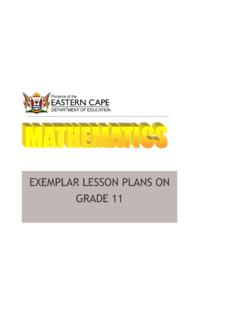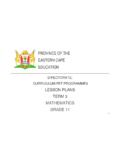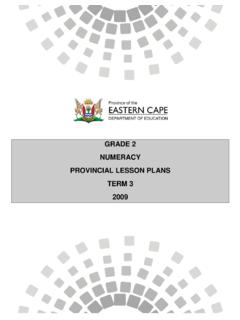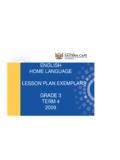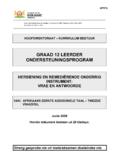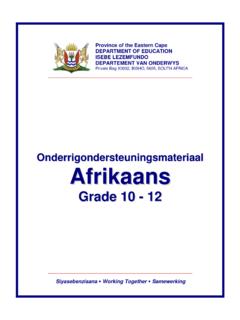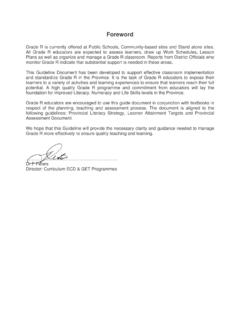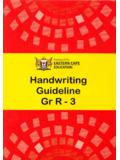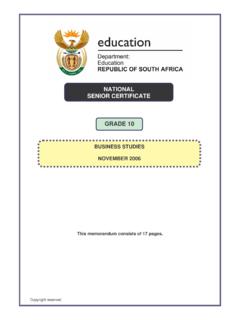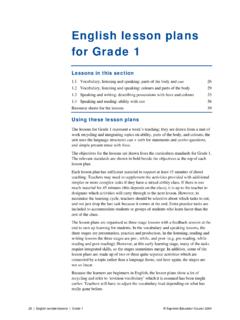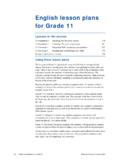Transcription of NATURAL SCIENCES EXEMPLARS OF LESSON …
1 PROVINCE OF THE EASTERN CAPE DEPARTMENT OF EDUCATION NATURAL SCIENCES EXEMPLARS OF LESSON ACTIVITIES INTERMEDIATE & SENIOR PHASE (GRADES 4-9) MARCH 2009 INTRODUCTION The Eastern Cape Department of Education, Curriculum Chief Directorate in collaboration with the District Curriculum Personnel developed the LESSON plans in this document to support teachers in their daily preparation to teach NATURAL SCIENCES . This NATURAL SCIENCES EXEMPLARS of Teaching and Learning Activities document contains a series of suggested activities that could be used by the teachers in their daily preparations to teach NATURAL SCIENCES .
2 It serves to support the teachers in their planning process and LESSON preparations. These activities are just few examples of activities which can be used in daily teaching. This document is a continuation of the document that was developed in November 2008 - Provincial NATURAL SCIENCES Resource Document for Planning, Teaching and Assessment. This document must be used together with the National Curriculum Statement, National Assessment Guidelines document, Provincial Assessment Guidelines document, Work Schedules and the Provincial NATURAL SCIENCES Resource Document for Planning, Teaching and Assessment. The activities/lessons must be adapted to suit the particular needs of the learners by including additional activities, assessment details and tools for assessment.
3 This document in no way is not prescriptive or final nor does it replace any other document / textbooks that are available for teaching. Teachers are encouraged to use this document as a resource together with a variety of available textbooks. The document does not in any way suggest that only the topics included in the document are to be taught in the various grades. Always follow the NCS policy for the Learning Area. NATURAL SCIENCES Learning Area has about 2 Hrs and 30 minutes per week, according to policy and teachers are advised to follow the activities according to time allocation. Note to teachers: Each LESSON plan consists of a number of Activities.
4 The time allocation for activities is indicated. These are suggested activities, use as guidelines, together with your work schedule. Feel free to adapt these activities. Choose activities that you think are very relevant. Pay attention to progression when dealing with same content in different grades. Choose available resources that suit your context. Make additions wherever necessary. Give class works and home works regularly. Vary the methods of assessments. Give time to learners to write notes on new content. Give short tests as part of informal assessment regularly.
5 Demonstrate practical activities and allow learners to take part in the activity. Give more credit to hands-on activities. Keep evidence of all daily classroom activities. Use different textbooks for content and as references. TABLE OF CONTENT NO CONTENT PAGES 1 Grade 4 Teaching and learning activities 5-19 2 Grade 4 LESSON EXEMPLARS 20-22 3 Grade 5 Teaching and learning activities 23-41 4 Grade 5 LESSON EXEMPLARS 42-44 5 Grade 6 Teaching and learning activities 45-63 6 Grade 6 LESSON EXEMPLARS 64-66 7 Grade 7 Teaching and learning activities 67-86 8 Grade 7 LESSON EXEMPLARS 87-88 9 Grade 8 Teaching and learning activities 89-103 10 Grade 8 LESSON EXEMPLARS 104-113 11 Grade 9 Teaching and learning activities 114-127 12 Grade 9 LESSON EXEMPLARS 128-135 SUGGESTED TEACHING AND LEARNING ACTIVITIES FOR NATURAL SCIENCES .
6 INTERMEDIATE PHASE GRADE: 4 LEARNING OUTCOMES AND ASSESSMENT STANDARDS: LO 1. Scientific Investigations: The learner will be able to act confidently on curiosity about NATURAL phenomena, and to investigate relationships and solve problems in scientific, technological and environmental contexts. AS 1. Plans Investigation; 2. Conducts investigation and collects data; 3. Evaluates data and communicate findings.
7 LO 2. Constructing Science Knowledge: The learner will know and be able to interpret and apply scientific, technological and environmental knowledge. AS 1. Recalls meaningful information; 2. Categorises information. LO 3 Science, Society and Environment: The learner will be able to demonstrate an understanding of the interrelationships between science and technology, society and the environment.
8 AS 1. Understands science and technology in the context of history and indigenous knowledge; 2. Understands the impact of science and technology. TERM-1 WEEKS TEACHING AND LEARNING ACTIVITIES ASSESSMENT RESOURCES WEEKS: 1-4 TOPICS: 1. WATER IN THE ECOSYSTEM 2. PHASES OF MATTER (please refer to the NATURAL SCIENCES Resource Document of November 2008) Assessment Task 1-the different states of matter(refer NS resource document) (refer NS resource document) WEEKS: 5-6 LIFE AND LIVING TOPIC: LIVING THINGS(Characteristics) LO1: As: 1,2 and 3 LO2: As: 1and 2 ACTIVITIES: Teacher uses pictures, charts and specimens to name the characteristics of living things.
9 Learners recall some of the features of animals and plants. Learners take a field trip to collect different plants and animals around the school. Make a list of different plants and animals. Identify and sort plants and animals according to observable features. Groups discuss similarities and differences between plants and animals. Complete tables about similarities and differences. Teacher summarises the characteristics of plants, animals and make a comparison. Write characteristics of plants and animals. Written work using tables to sort plants and animals. Make a drawing of a plant and an animal to show the main external features.
10 Write down the similarities and differences between plants and animals. Books Newspaper Magazines Specimens of plants and animals WEEK:7 TOPIC; PARTS OF A PLANT LO1: AS 1, 2 and 3 LO 2: AS 1and 2 ACTIVITIES: Learners recall the characteristics of plant. Collect small plants, observe and name the parts. Teacher explains the functions of the different parts of a plant. Learners identify parts of a plant. Learners observe a chart showing the parts of a plant and compare it to the real plant that they brought to the class. Observe different types of plants. a bean plant, tomato plant, maize plant to compare its parts.
